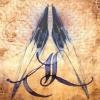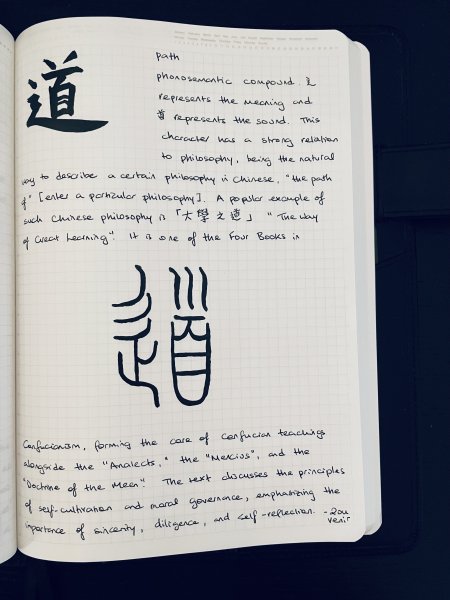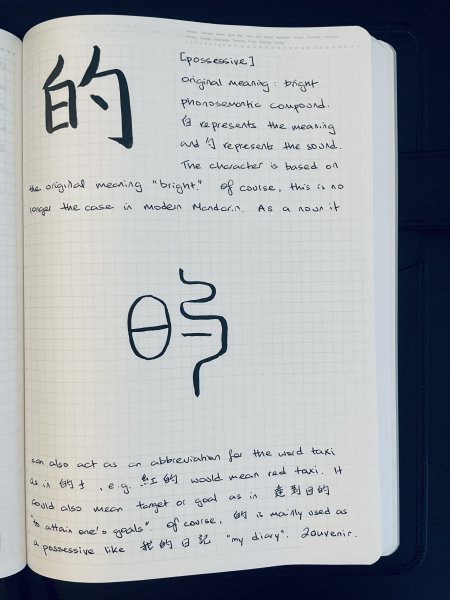Search the Community
Showing results for tags 'chinese calligraphy'.
-
Doing some Chinese character studies of the most commonly used characters. I intend to do one a day for at least 1000 characters! It's fun and you should totally join me in this journey! Feel free to do your own character study and post it in the gallery (or here in this thread)! Today I will do the character 的. In Chinese, the character 的 is one of the most commonly used characters and serves several grammatical functions. Its primary usage is as a possessive particle, indicating possession or association. Here's a breakdown of its main functions: 1. Possessive Particle: 的 is commonly used to indicate possession or association between nouns. For example: - 我的书 - "my book" - 他的车 - "his car" - 中国的文化 - "Chinese culture" 2. Adjectival Modifier: 的 can also be used to turn a phrase or clause into an adjective to modify a noun. For example: - 美丽的花 (měilì de huā) - "beautiful flowers" - 好吃的食物 (hǎochī de shíwù) - "delicious food" 3. Nominalizing Suffix: In some cases, 的 is used to turn a verb or a phrase into a noun. For example: - 做饭的 (zuòfàn de) - "the one who cooks" or "cooking" - 看书的 (kànshū de) - "the one who reads" or "reading" 4. Emphasizing Possession: Sometimes, "的" is used for emphasis, especially in written or literary contexts. For example: - 他的书 (tā de shū) - "his book" (standard) - 他书的 (tā shū de) - "his book" (emphasizing possession) 5. Part of Compound Words: "的" is also used as a component in many compound words and phrases, such as "的确" (díquè) meaning "indeed" or "certainly," or "安全的" (ānquán de) meaning "safe." Overall, "的" is an indispensable character in Chinese, playing a crucial role in indicating possession, forming adjectives, nominalizing phrases, and more. Its versatility and frequency of use make it an essential element of the language. Pens/Inks: Kuretake Fountain Pen Brush No. 50 with original pigment cartridge, Pilot Prera F with Pilot Black Paper: A5 Stalogy 365 full year size Notes: I will be using both traditional and simplified characters, view at your own discretion. This is not a lesson in Chinese language, will be mostly focusing on the calligraphy and aesthetics. I will do the calligraphy in traditional character and brief explanation in English scattered with traditional or simplified Chinese. In addition to the regular script, I will experiment with other scripts like the ancient "small seal" script.
- 19 replies
-
- chinese
- calligraphy
- (and 5 more)
-
From the album: j1tters
A self-correction note: the horizontal strokes are a little unevenly spaced in 首 in the regular script, and perhaps the 辶 shouldn't be touching the 首; not the easiest character to write. In hindsight I really should be practising the characters on a spare sheet of paper before writing this in my journal. But I guess I am too lazy to have done that. I may (or not!) try to be more mindful next time.
- 0 B
- x
-
- chinese calligraphy
- calligraphy
- (and 3 more)
-
From the album: j1tters
Doing some Chinese character studies of the most commonly used characters. I intend to do one a day for at least 1000 characters! It's fun and you should totally join me in this journey! Feel free to do your own character study and post it in the gallery! Today I will do the character 的. In Chinese, the character 的 is one of the most commonly used characters and serves several grammatical functions. Its primary usage is as a possessive particle, indicating possession or association. Here's a breakdown of its main functions: 1. Possessive Particle: 的 is commonly used to indicate possession or association between nouns. For example: - 我的书 - "my book" - 他的车 - "his car" - 中国的文化 - "Chinese culture" 2. Adjectival Modifier: 的 can also be used to turn a phrase or clause into an adjective to modify a noun. For example: - 美丽的花 (měilì de huā) - "beautiful flowers" - 好吃的食物 (hǎochī de shíwù) - "delicious food" 3. Nominalizing Suffix: In some cases, 的 is used to turn a verb or a phrase into a noun. For example: - 做饭的 (zuòfàn de) - "the one who cooks" or "cooking" - 看书的 (kànshū de) - "the one who reads" or "reading" 4. Emphasizing Possession: Sometimes, "的" is used for emphasis, especially in written or literary contexts. For example: - 他的书 (tā de shū) - "his book" (standard) - 他书的 (tā shū de) - "his book" (emphasizing possession) 5. Part of Compound Words: "的" is also used as a component in many compound words and phrases, such as "的确" (díquè) meaning "indeed" or "certainly," or "安全的" (ānquán de) meaning "safe." Overall, "的" is an indispensable character in Chinese, playing a crucial role in indicating possession, forming adjectives, nominalizing phrases, and more. Its versatility and frequency of use make it an essential element of the language. Pens/Inks: Kuretake Fountain Pen Brush No. 50 with original pigment cartridge, Pilot Prera F with Pilot Black Paper: A5 Stalogy 365 full year size
- 0 B
- x
-
- chinese calligraphy
- chinese
-
(and 4 more)
Tagged with:
-
I just found this mini-documentary on YouTube and found it fascinating so I thought I'd share it.
- 6 replies
-
- japanese calligraphy
- sumi ink
- (and 8 more)
-
Exploring Chinese Calligraphy with Fountain Pens: Share Your Experiences!
2ouvenir posted a topic in Calligraphy Discussions
Greetings fellow fountain pen enthusiasts! I'm starting this thread to connect with others who share this interest and to learn more about your experiences with Chinese calligraphy using fountain pens. Whether you're a seasoned practitioner or just dipping your nib into this art form, I'd love to hear from you! Here are a few prompts to get the conversation going: How did you first become interested in Chinese calligraphy? Do you actively practice Chinese calligraphy with your fountain pens? If so, what pens and inks do you prefer? What challenges have you encountered when adapting Chinese calligraphy techniques to fountain pen writing? Are there any particular resources, books, or online tutorials that have helped you improve your skills? Do you have any favorite Chinese calligraphy styles or scripts that you enjoy writing the most? Feel free to share tips, tricks, favorite tools, or simply your thoughts and experiences. Let's explore the world of Chinese calligraphy together and celebrate the beauty of writing with fountain pens! Personally, I just use a regular Japanese fine for all my Chinese "calligraphy" (some might argue you can only do Chinese calligraphy with an ink brush, I differ) and any fountain pen friendly paper with a light grid layout. The ink should be legible, i.e. not too light. A tip I have is to do reverse writing (if your fountain pen allows) for characters that are extremely complex like 鬢 to get all the details within the confines of your grid, if you decide to have all your characters have the "same size" and equally spaced apart. Before, I go, some inspiration: Looking forward to hearing from you all! Warm regards, 2ouvenir-
- chinese calligraphy
- calligraphy
-
(and 3 more)
Tagged with:
-

(Video) Homemade Paint Brush-Like Calligraphy Nib
andybiotic posted a topic in Fountain & Dip Pens - First Stop
This is just a Pilot Prera with a regular steel nib, nothing special... But then I carefully and methodically bent the tip of the nib into a smooth curve (and smoothed it), and now the topside (engraving side) of the nib is able to put ink down somewhat similar to an oriental paint brush with a large variety of line widths depending on the writing angle and pressure used. It also gives sharp pointy end strokes (not sure what the technical term is...) if done properly. The bottom (normally correct) side of the nib still writes in extra fine lines. This is similar to the Condor (trademarked) nib by Mr. Richard Binder (I am not saying this IS the Condor nib). Of course, Mr. Binder can do a much better job than me and his nibs are much much more professionally finished than mine. But for what it is worth, it is a very good attempt. (I am not selling a service here, it is just a demonstration) This nib is able to produce Japanese (Kanji) or Chinese calligraphy when used carefully and in specific ways as shown in the end of the video. Although I've never tried it, it should be able to do a certain degree of painting / drawing as well. I have more fountain pen / writing related videos on my youtube channel if anyone is interested.- 4 replies
-
- calligraphy
- nib modification
- (and 5 more)



